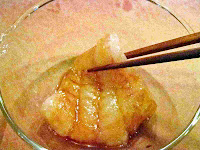<Ingredients>
2 tsp dashi
1 tsp sake
1 tsp mirin
1 tsp soy sauce
30-50 g shiromizakana white fish (45 g cod in photo)
1/2 tsp soy sauce (for marinating fish; not in photo)
1/2 tsp sake (for marinating fish; not in photo)
Tiny handful (4 small stems) saishin yu choy sum
Oil (for frying omelet; not in photo)
<Directions>
1.
Pour soy sauce and sake over fish, and marinate for 20-30 minutes (at least 10 minutes).
Flip once or twice for even absorption.
2.
In a frying pan, place a small sheet of parchment paper, and cook fish on top.
When done (flesh turns opaque), pour marinade over fish, and cook until liquid is almost gone.
When cool enough to handle, break into thinner pieces.
3.
Meanwhile, bring water to boil, add pinch salt (optional), and blanch yu choy sum, starting with stem ends.
When leaves turn bright, remove from water and let cool on zaru drainer or plate.
(Stem ends and leaf tops are piled alternately to obtain an even thickness of yu choy sum in photo.)
4.
Lightly beat eggs.
Move chopsticks to cut apart egg whites; do not whip.
Add dashi, sake, mirin and soy sauce, and mix well.
5.
Heat oil, and wipe off excess oil with a paper towel (save the towel for later).
Reduce heat to medium low, pour 1/3 of egg mixture, and quickly poke bubbles with chopsticks.
Place fish and yu choy sum in the center or 2/3 from the other end of pan, and role the egg over.
If difficult, use a spatula to roll it.
6.
Apply oil in the open space of pan with the paper towel used to absorb excess oil.
Move omelet to the far end, and apply oil in the open front area.
Pour 1/2 of the remaining egg mixture.
Lift omelet at the far end so that egg mixture also goes underneath.
Quickly poke with chopsticks, and roll.
7.
Repeat one more time.
Lower heat somewhat, and cook until egg is set.
8.
Cut into desired number of pieces.
<Notes>
- Partly because only 2 eggs are used, the first part -- pouring the egg mixture, placing fillings and rolling -- needs to be done quickly to get a fluffy omelet. Ideally, the surface of egg should still be uncooked when rolling in fillings. (The egg surface in the photo is pretty dry especially at the far end due to the time it took to take pictures -- a bad example.)
- For the above amount, 40 g fish (about 7-8 cm square) is good. If you use more than 50g fish, it could be difficult to wrap together with greens, as the fillings tend to overflow the first layer of omelet. If this happens, stay calm, and form a tube-shape filling-egg mixture (if you cannot roll it at all). As long as the fillings and egg somehow stay together, you can fix it with the second and third egg mixture layers. If the finished omelet still needs help, roll it with a makisu sushi scroll to stabilize the shape.
- Fish and vegetable can be prepared in advance, even a day ahead. Cook fish while fresh!
- If you marinate fish for 30 minutes, pouring the marinade after fish is done is optional, especially if your fish is low in fat (cod and sole, for example).
- Fish can also be microwaved instead of frying.
- Fish with some fat content, such as lingcod and rockfish, taste best.
- For the greens, any leafy green or green beans work. Among my first choices are nanohana, yu choy sum, mustard greens, mizuna & mibuna (green part only), arugula, komatsuna, chingensai baby bok choy (green part only), daikon & kabu leaves and asparagus.
- Shiromizakana is a general term for "white flesh" fish.
(Last updated: July 17, 2014)

























No comments:
Post a Comment